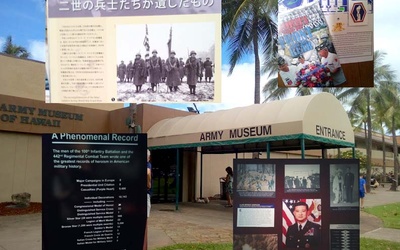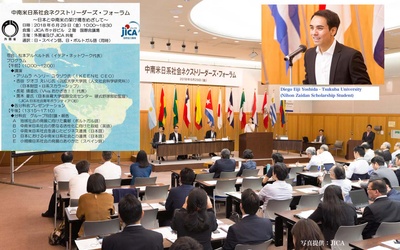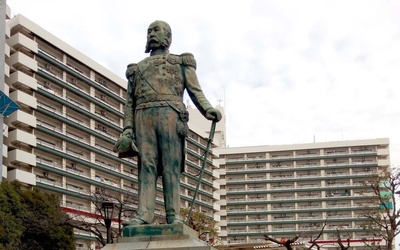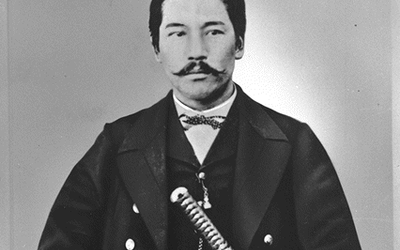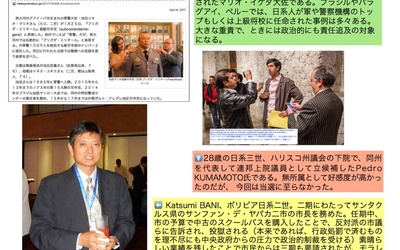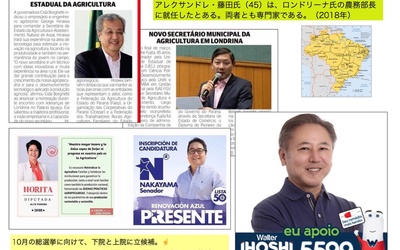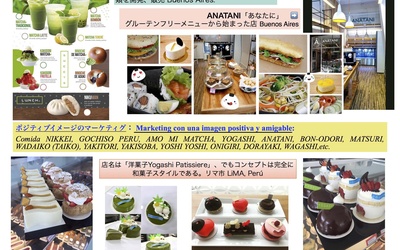
Alberto J. Matsumoto
@albertomatsumotoNisei Japanese-Argentine. In 1990, he came to Japan as a government-financed international student. He received a Master’s degree in Law from the Yokohama National University. In 1997, he established a translation company specialized in public relations and legal work. He was a court interpreter in district courts and family courts in Yokohama and Tokyo. He also works as a broadcast interpreter at NHK. He teaches the history of Japanese immigrants and the educational system in Japan to Nikkei trainees at JICA (Japan International Cooperation Agency). He also teaches Spanish at the University of Shizuoka and social economics and laws in Latin America at the Department of law at Dokkyo University. He gives lectures on multi-culturalism for foreign advisors. He has published books in Spanish on the themes of income tax and resident status. In Japanese, he has published “54 Chapters to Learn About Argentine” (Akashi Shoten), “Learn How to Speak Spanish in 30 Days” (Natsumesha) and others. http://www.ideamatsu.com
Updated June 2013
Stories from This Author
Japan in the Heisei Era and Japanese South American Workers Who Have Established Their Lives
Feb. 24, 2020 • Alberto J. Matsumoto
In 2019, the era name "Heisei" ended in Japan and "Reiwa" began. The 31-year Heisei era almost overlaps with the history of Japanese workers from South America coming to Japan. During the bubble period in the late 1980s, in order to solve the serious labor shortage problem in the manufacturing industry, the government revised the immigration law to allow second and third generation Japanese from South America and their spouses to work in Japan without restrictions. At that time, the …
"GANNENMONO" and "Japanese Legacy" in Hawaii
Feb. 7, 2020 • Alberto J. Matsumoto
In June 2018, a major event in the history of Japanese overseas migration was held in Honolulu, Hawaii. It was the "Gannenmono" ceremony celebrating the 150th anniversary of Japanese immigration to Hawaii, and was attended by Prince and Princess Akishino from Japan, and by the government, including former Self-Defense Forces officer and Vice-Minister for Foreign Affairs Sato Masahisa, and JICA President Kitaoka Shinichi. Hawaii representatives included Governor Ige, former Governor Ariyoshi, Honolulu Mayor Amemiya, Japan-U.S. Council Chairwoman Irene Hirano Inouye …
The Significance and Effects of the Japanese American Next Generation Leaders Forum
Sept. 18, 2019 • Alberto J. Matsumoto
For the past few years, the Japanese Ministry of Foreign Affairs has been inviting the next generation of Japanese leaders from Latin America. I have been involved in this project for the past six years at the request of the Ministry of Foreign Affairs' Latin America and Caribbean Affairs Bureau. Despite the tight schedule, the invited Japanese people have the opportunity to meet with relevant organizations and sometimes even the Prime Minister. This is because the Japanese government hopes that …
The Man Who Entrusted His Dream of Emigrating Overseas to the Mexican Enomoto Colonization Corps - Part 2
March 14, 2019 • Alberto J. Matsumoto
Read Part 1 >> Colonization to Chiapas, Mexico Even after leaving the Ministry of Foreign Affairs, Enomoto Takeaki continued to pursue his dream of overseas colonization. In 1893, he founded the Colonization Association and launched a project to send colonists overseas. They set their sights on Mexico, which had already concluded a Treaty of Amity and Commerce with Japan in 1888 and opened the first consulate in Latin America in 1891. At the time, Mexico was ruled by Porfirio Diaz, …
The Man Who Entrusted His Dream of Emigrating Overseas to the Mexican Enomoto Colonization Corps: Enomoto Takeaki - Part 1
March 13, 2019 • Alberto J. Matsumoto
Japanese overseas immigration, which began with the Meiji Restoration, marked 150 years in 2018 since the first group arrived in the Kingdom of Hawaii. Many Japanese people subsequently emigrated to the mainland United States and Central and South America. The first immigrants to Mexico were the Enomoto Colonization Group, which settled in Escuintla, Chiapas in 1897. This group was promoted by Enomoto Takeaki, former Minister of Foreign Affairs of the Meiji government. However, many of the immigrants fled the colony …
Legal reforms lead to further increase in technical intern trainees from Asian countries: new challenges for Japanese workers
Jan. 21, 2019 • Alberto J. Matsumoto
A new immigration law will come into effect in April 2019. In addition to the existing "Technical Intern Training" residence status, a new "Specified Skilled Worker" visa will be introduced, and Japan is trying to accept 370,000 foreign workers over the next few years. Industries and departments with serious labor shortages are interested in this "Specified Skilled Worker" visa. This visa will extend the stay period from the current three years to five years, and if certain conditions are met, …
Political Activism of Japanese Americans in Latin America - Part 2
Nov. 29, 2018 • Alberto J. Matsumoto
Read Part 1 >> At the Society for Latin American Studies held at Aichi Prefectural University in June this year1, Yukako Nagamura, a member of the Graduate School of Sophia University, gave an interesting presentation on "Positioning and career strategies of Japanese politicians under the Brazilian military regime" 2 . According to her presentation, after the war, second and third generation Japanese politicians entered the political world one after another, promising to improve the status and advance in society of …
Political Activism of Japanese Americans in Latin America - Part 1
Nov. 28, 2018 • Alberto J. Matsumoto
In Latin America, dictatorships were once the rule of many countries, but over the past 30 years, democratization has progressed despite political instability. However, even in "democratic governments" established through elections, there are many countries where the activities of opposition parties are restricted and politicians are imprisoned or jailed, and political violence is still occurring. Perhaps for this reason, there has long been a strong sense of caution in the Japanese community regarding political activity by Japanese people of Latin …
Japanese "Food and Shops" in Roman alphabet
Nov. 16, 2018 • Alberto J. Matsumoto
Aside from "sushi," "tempura," "yakisoba," and "yakitori," which were already somewhat well known around the world before the Japanese food boom began, the words "onigiri" and "dorayaki" are now often seen written in the Roman alphabet. Not only are they used for Japanese food ingredients and menus, but recently they are also being used in store and company names to create a familiar and memorable impression. In recent years in South America, it has become common to see this kind …
The Japanese-Americans I met at university
May 23, 2018 • Alberto J. Matsumoto
"Japanese-descendant dekasegi" workers from South America began coming to Japan in the late 1980s, and after the Immigration Control Act was revised in 1990, they began entering in large numbers. At first, many Japanese-descendants came alone, but gradually they began to consider staying in Japan longer, and began to bring their families over or start homes here. As a result, the number of children attending Japanese schools has increased, and since around 2005, foreign support offices have been receiving more …


